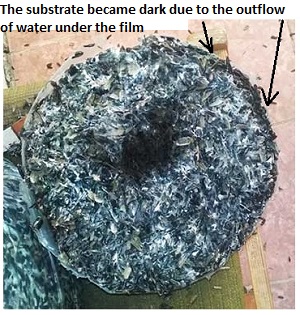
What’s the best air temperature for oyster mushroom incubation — and what happens if it’s too high or too low? Let’s break it down in simple terms.
Table of Contents
What happens if the temperature is lower or higher than optimal?
In the first few days after inoculation, the most important thing is the fast and healthy growth of oyster mushroom mycelium. That’s your goal.
But let’s not forget: after heat treatment, your substrate still contains living microorganisms. They’ll also start growing—and release heat, CO₂ and moisture.
So, if you don’t manage the temperature during incubation, things can get out of control fast. The blocks can overheat, and your mycelium will suffer.
Let’s talk about how to avoid that.
The ideal air temperature in the incubation room depends on the strain of oyster mushroom you’re growing.
The manufacturer of your grain spawn should list the incubation temperature in the strain description.
But in general:
▶️18°C (64°F) — for winter strains
▶️22–23°C (71–73°F) — for fast-growing summer strains
Best temp for mycelium growth
💡The key thing: pick one temperature and keep it steady throughout the incubation period. For example, 22°C (72°F) from start to finish.
If you’re growing in a cold place and it’s hard to hold 22°C, you can go down to 19–20°C (66–68°F), but not lower.
Several reasons can inhibit the growth of mycelium, causing us to think that it is growing slowly.
📌For example, problems with the substrate.
But, even if the substrate is disinfected correctly, low temperature is a factor in the slow growth of mycelium.
If the air is too cold, mycelium will grow slowly or stop altogether.
That’s not just about time — at low temperatures, your substrate becomes more vulnerable to mold and bacteria.
Some blocks may stay clean, but you’ll likely get patchy growth and eventually some contamination.
Even if your raw materials were processed perfectly, you’ll lose weeks waiting for colonization at 12–15°C (53–59°F). That’s too long.
You can go a bit above 23°C (73°F), but you’re entering risky territory.
When the air is warmer than 25°C (77°F), the core of your mushroom blocks can hit 36–37°C (96–99°F).
That’s a critical zone. The mycelium may slow down, or even die.
If you’re running incubation at 24°C or more, watch your blocks closely.
Check the temperature in the center. If they start to heat up, gently bring the room temp down to 21–22°C (69–72°F).
💡But lower the temperature slowly — a sudden drop causes condensation, and that brings its own problems.

If the core of the block stays above 36°C (96°F) for more than 24 hours, mycelium will die in the center. You’ll see a dark, “burnt” spot when you cut the block open.
Even if the rest of the block looks white, yield will be lower.
📌We’ll talk more about this in a separate article.
Your job as a grower is to organize airflow around the bags so they don’t overheat, and to keep the room temperature stable and close to your target setting.
Use equipment you can trust — the two easiest options are:
✅A split system (mini-split HVAC) — to heat and cool as needed
✅Underfloor heating — useful in cold climates, especially in winter
Avoid cooling the room with large amounts of outdoor air. It causes water to condense under the plastic film, and that can lead to undergrowth or contamination.
A good airflow system with recirculation helps a lot. It evens out the temperature and keeps the blocks from overheating.
Use air conditioning if needed — just don’t blast in cold air suddenly. Cool things gradually, especially if the blocks are still heating up.
Up next: How to cool mushroom blocks before fruiting — safely and without damaging the mycelium.
